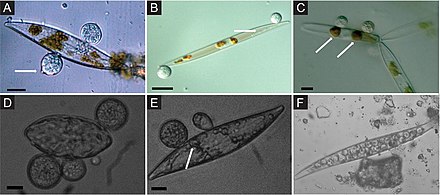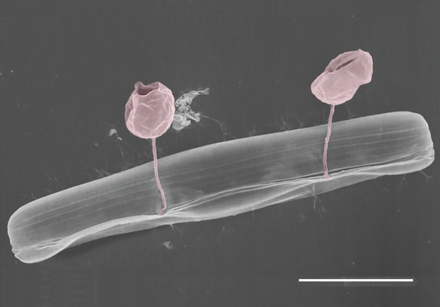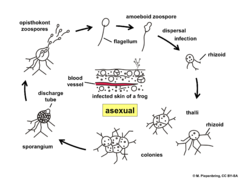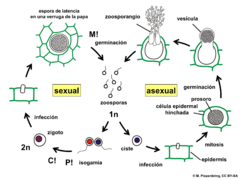Chytridiomycota
| Chytridiomycota | |
|---|---|

| |
| Sporangiumof aspizellomycete | |
| Scientific classification | |
| Domain: | Eukaryota |
| Kingdom: | Fungi |
| Division: | Chytridiomycota Hibbett et al. (2007) |
| Classes/orders | |
Chytridiomycotaare a division ofzoosporicorganisms in thekingdomFungi,informally known aschytrids.The name is derived from theAncient Greekχυτρίδιον(khutrídion), meaning "little pot", describing the structure containing unreleasedzoospores.Chytrids are one of the earliest diverging fungal lineages, and their membership in kingdom Fungi is demonstrated withchitincell walls,a posterior whiplashflagellum,absorptive nutrition, use ofglycogenas an energy storage compound, and synthesis oflysineby theα-aminoadipic acid(AAA) pathway.[2][3]
Chytrids aresaprobic,degrading refractory materials such aschitinandkeratin,and sometimes act asparasites.[4]There has been a significant increase in the research of chytrids since the discovery ofBatrachochytrium dendrobatidis,the causal agent ofchytridiomycosis.[5][6]
Classification[edit]
Species of Chytridiomycota have traditionally been delineated and classified based on development, morphology, substrate, and method of zoospore discharge.[7][4]However, single spore isolates (or isogenic lines) display a great amount of variation in many of these features; thus, these features cannot be used to reliably classify or identify a species.[7][4][8]Currently,taxonomyin Chytridiomycota is based on molecular data, zoosporeultrastructureand some aspects of thallus morphology and development.[7][8]
In an older and more restricted sense (not used here), the term "chytrids" referred just to those fungi in theclassChytridiomycetes.Here, the term "chytrid" refers to all members of Chytridiomycota.[2]
The chytrids have also been included among theProtoctista,[7]but are now regularly classed as fungi.
In olderclassifications,chytrids, except the recently establishedorderSpizellomycetales,were placed in the classPhycomycetesunder the subphylum Myxomycophyta of the kingdom Fungi. Previously, they were placed in theMastigomycotinaas the class Chytridiomycetes.[9]The other classes of the Mastigomycotina, theHyphochytriomycetesandoomycetes,were removed from the fungi to be classified asheterokontpseudofungi.[10]
The classChytridiomyceteshas over 750 chytrid species distributed among tenorders.[11][12][13]Additional classes include theMonoblepharidomycetes,[14]with two orders, and theHyaloraphidiomyceteswith a single order.[15]
Molecular phylogenetics,and other techniques such asultrastructureanalysis, has greatly increased the understanding of chytrid phylogeny, and led to the formation of several newzoosporicfungalphyla:
- The orderBlastocladiales,originally within the Chytridiomycota, are now classified as a separate phylum, theBlastocladiomycota.[16]
- TheNeocallimastigales,originally an order ofanaerobicfungiof the class Chytridiomycetes, found in the digestive tracts of herbivores, was later raised to a separate phylum, theNeocallimastigomycota.[15]
- TheOlpidiaceae,including thetype genusOlpidium,formerly classified in the orderChytridiales,were raised to a separate phylum, theOlpidiomycota.[17]
Life cycle and body plan[edit]
Chytridiomycota are unusual among the Fungi in that they reproduce with zoospores.[4][18]For most members of Chytridiomycota, sexual reproduction is not known. Asexual reproduction occurs through the release of zoospores (presumably) derived throughmitosis.[4]
Where it has been described, sexual reproduction of chytrids occurs via a variety of methods. It is generally accepted that the resulting zygote forms a resting spore, which functions as a means of surviving adverse conditions.[4]In some members, sexual reproduction is achieved through the fusion ofisogametes(gametes of the same size and shape). This group includes the notable plant pathogensSynchytrium.Some algal parasites practiceoogamy:A motile male gamete attaches itself to a nonmotile structure containing the female gamete. In another group, twothalliproduce tubes that fuse and allow the gametes to meet and fuse.[4]In the last group, rhizoids of compatible strains meet and fuse. Both nuclei migrate out of the zoosporangium and into the conjoined rhizoids where they fuse. The resulting zygote germinates into a resting spore.[2]
Sexual reproduction is common and well known among members of the Monoblepharidomycetes. Typically, these chytrids practice a version ofoogamy:The male is motile and the female is stationary. This is the first occurrence of oogamy in kingdom Fungi.[3]Briefly, the monoblephs form oogonia, which give rise to eggs, and antheridia, which give rise to male gametes. Once fertilized, the zygote either becomes an encysted or motile oospore,[4]which ultimately becomes a resting spore that will later germinate and give rise to new zoosporangia.[3]
-
Life cycleofBatrachochytrium dendrobatidis
-
Life cycle ofSynchytrium endobioticumin potato
-
Synchytrium endobioticumon potatoes.
Upon release from the germinated resting spore, zoospores seek out a suitable substrate for growth usingchemotaxisorphototaxis.Some species encyst and germinate directly upon the substrate; others encyst and germinate a short distance away. Once germinated, enzymes released from the zoospore begin to break down the substrate and utilize it produce a newthallus.Thalli arecoenocyticand usually form no truemycelium(havingrhizoidsinstead).
Chytrids have several different growth patterns. Some are holocarpic, which means they only produce azoosporangiumandzoospores.Others are eucarpic, meaning they produce other structures, such asrhizoids,in addition to the zoosporangium and zoospores. Some chytrids are monocentric, meaning a single zoospore gives rise to a single zoosporangium. Others are polycentric, meaning one zoospore gives rise to many zoosporangium connected by a rhizomycelium. Rhizoids do not have nuclei while a rhizomycelium can.[3]
-
Types of chytrid thalli
-
Zoospore discharge fromPhylctochytriumsp.
-
Chytridsporangiumandzoosporesunder the microscope
Growth continues until a new batch of zoospores are ready for release. Chytrids have a diverse set of release mechanisms that can be grouped into the broad categories of operculate or inoperculate. Operculate discharge involves the complete or incomplete detachment of a lid-like structure, called an operculum, allowing the zoospores out of the sporangium. Inoperculate chytrids release their zoospores through pores, slits, or papillae.[4]
Habitats[edit]
Chytrids areaquatic fungi,though those that thrive in the capillary network around soil particles are typically considered terrestrial.[7][4]The zoospore is primarily a means of thoroughly exploring a small volume of water for a suitable substrate rather than a means of long-range dispersal.[19]
Chytrids have been isolated from a variety of aquatic habitats, including peats, bogs, rivers, ponds, springs, and ditches, and terrestrial habitats, such as acidic soils, alkaline soils, temperate forest soils, rainforest soils, Arctic and Antarctic soils.[7][4]This has led to the belief that many chytrid species are ubiquitous and cosmopolitan.[7][4]However, recent taxonomic work has demonstrated that this ubiquitous and cosmopolitan morphospecies hide cryptic diversity at the genetic and ultrastructural levels.[20][21]It was first thought aquatic chytrids (and other zoosporic fungi) were primarily active in fall, winter, and spring.[4]However, recent molecular inventories of lakes during the summer indicate that chytrids are an active, diverse part of the eukaryotic microbial community.[22]
One of the least expected terrestrial environments the chytrid thrive in are periglacial soils.[23]The population of the Chytridiomycota species are able to be supported even though there is a lack of plant life in these frozen regions due to the large amounts of water in periglacial soil and pollen blowing up from below the timberline.
Ecological functions[edit]


Batrachochytrium dendrobatidis[edit]
The chytridBatrachochytrium dendrobatidisis responsible forchytridiomycosis,a disease of amphibians. Discovered in 1998 inAustraliaandPanamathis disease is known to killamphibiansin large numbers, and has been suggested as a principal cause for the worldwideamphibian decline.Outbreaks of the fungus were found responsible for killing much of theKihansi Spray Toadpopulation in its native habitat ofTanzania,[26]as well as the extinction of thegolden toadin 1989. Chytridiomycosis has also been implicated in the presumed extinction of the Southern Gastric Brooding Frog,[27]last seen in the wild in 1981, and the Northern Gastric Brooding Frog, last recorded in the wild in March 1985.[28]The process leading to frog mortality is thought to be the loss of essential ions through pores made in the epidermal cells by the chytrid during its replication.[29]
Recent research has revealed that elevating salt levels slightly may be able to cure chytridiomycosis in some Australian frog species,[30]although further experimentation is needed.
Other parasites[edit]
Chytrids mainly infect algae and othereukaryoticandprokaryoticmicrobes. The infection can be so severe as to control primary production within the lake.[3][31]It has been suggested that parasitic chytrids have a large effect on lake and pond food webs.[32]Chytrids may also infect plant species; in particular,Synchytrium endobioticumis an importantpotatopathogen.[33]
Saprobes[edit]
Arguably, the most important ecological function chytrids perform is decomposition.[7]These ubiquitous and cosmopolitan organisms are responsible for decomposition of refractory materials, such aspollen,cellulose,chitin,andkeratin.[7][4] There are also chytrids that live and grow on pollen by attaching threadlike structures, called rhizoids, onto the pollen grains.[34]This mostly occurs during asexual reproduction because the zoospores that become attached to the pollen continuously reproduce and form new chytrids that will attach to other pollen grains for nutrients. This colonization of pollen happens during the spring time when bodies of water accumulate pollen falling from trees and plants.[4]
-
Dead frog with chytridiomycosis (B. dendrobatidis) signs
Fossil record[edit]
The earliestfossilsof chytrids are from theScottishRhynie chert,aDevonian-agelagerstättewith anatomical preservation ofplantsand fungi. Among the microfossils are chytrids preserved asparasitesonrhyniophytes.These fossils closely resemble the modern genusAllomyces.[35]Holocarpic chytrid remains were found in cherts from Combres in central France that date back to the lateVisean.These remains were found along with eucarpic remains and are ambiguous in nature although they are thought to be of chytrids.[36]Other chytrid-like fossils were found in cherts from the upperPennsylvanianin theSaint-EtienneBasin inFrance,dating between 300~350ma.[37]
In fictional media[edit]
The novelTom Clancy's Splinter Cell: Fallout(2007) features a species of chytrid that feeds on petroleum and oil-based products. In the story the species is modified usingnuclear radiation,to increase the rate at which it feeds on oil. It is then used byIslamic extremistsin an attempt to destroy the world's oil supplies, thereby taking away the technological advantage of theUnited States.[38]
References[edit]
- ^ Tedersoo, Leho; Sanchez-Ramırez, Santiago; Koljalg, Urmas; Bahram, Mohammad; Doring, Markus; Schigel, Dmitry; et al. (22 February 2018)."High-level classification of the Fungi and a tool for evolutionary ecological analyses".Fungal Diversity.90(1): 135–159.doi:10.1007/s13225-018-0401-0.
- ^abcAlexopoulos, C.J.; Mims, C.W.; Blackwell, M. (1996).Introductory Mycology(4th ed.). John Wiley & Sons.
- ^abcde
Kendrick, Bryce (2000).The Fifth Kingdom(3rd ed.). Newburyport, MA: Focus Publishing. - ^abcdefghijklmno
Sparrow, F.K. (1960).Aquatic Phycomyete(2nd ed.). Ann Arbor, MI: The University of Michigan Press. - ^Blackwell, M. (2011). "The Fungi: 1,2,3… million species?".American Journal of Botany.98(3): 426–438.doi:10.3732/ajb.1000298.PMID21613136.
- ^Longcore, J.E.; Pessier, A.P.; Nichols, D.K. (1999). "Batrachochytirum dendrobatidisgen. et sp. nov., a chytrid pathogenic to amphibians ".Mycologia.91(2): 219–227.doi:10.1080/00275514.1999.12061011.
- ^abcdefghi
Barr, D.J.S. (1990). "Phylum Chytridiomycota". In Margulis; Corliss; Melkonian; Chapman (eds.).Handbook of Protoctista.Boston, MA: Jones & Barlett. pp. 454–466. - ^abBlackwell, W.H.; Letcher, P.M.; Powell, M.J. (2006). "Thallus development and the systematics of Chytridiomycota: an additional developmental pattern represented by Podochytrium".Mycotaxon.97:91–109.
- ^Ainsworth; Sparrow; Sussman, eds. (1973).The Fungi: An advanced treatise.Vol. IVB A – Taxonomic review with keys: Basidiomycetes and lower fungi. New York, NY: Academic Press.
- ^van der Auwera, G.; de Baere, R.; van de Peer, Y.; de Rijk, P.; van den Broeck, I.; de Wachter, R. (July 1995). "The phylogeny of the Hyphochytriomycota as deduced from ribosomal RNA sequences ofHyphochytrium catenoides".Mol. Biol. Evol.12(4): 671–678.doi:10.1093/oxfordjournals.molbev.a040245.PMID7659021.
- ^"Chytrid fungi online – an NSF / PEET project website".Tuscaloosa, AL: University of Alabama.Retrieved16 April2022.
- ^Esser, K. (2014).The Mycota.Vol. VII A: Systematics and evolution (2nd ed.). Springer. p. 461.ISBN978-3-642-55317-2.
- ^Powell; Letcher (20 January 2017) [2015]."A new genus and family for the misclassified chytrid,Rhizophlyctis harderi".Mycologia.107(2): 419–431.doi:10.3852/14-223.PMID25572098.S2CID24144836.Retrieved23 August2016.
- ^Dee, J.M.; Mollicone, M.; Longcore, J.E.; Roberson, R.W.; Berbee, M.L. (2015). "Cytology and molecular phylogenetics of Monoblepharidomycetes provide evidence for multiple independent origins of the hyphal habit in the Fungi".Mycologia.107(4): 710–728.doi:10.3852/14-275.ISSN0027-5514.PMID25911696.S2CID40241045.
- ^abMisra, J.K.; Tewari, J.P.; Deshmukh, S.K. (10 January 2012).Systematics and Evolution of Fungi.CRC Press. p. 47.ISBN978-1-57808-723-5.
- ^James, T.Y.; et al. (2006). "A molecular phylogeny of the flagellated fungi (Chytridiomycota) and description of a new phylum (Blastocladiomycota) ".Mycologia.98(6): 860–871.doi:10.3852/mycologia.98.6.860.PMID17486963.
- ^"Item no. 42"(PDF).Index Fungorum.
- ^Hibbett; et al. (2007). "A higher-level phylogenetic classification of the Fungi".Mycologia.111(5): 509–547.doi:10.1016/j.mycres.2007.03.004.PMID17572334.S2CID4686378.
- ^Carlile, M.J. (1986). "The zoospore and its problems". In Ayres, Peter G.; Boddy, Lynne (eds.).Water, Fungi, and Plants.Vol. 11. Cambridge University Press.
- ^Letcher, P.M.; et al. (2008). "Rhizophlyctidales – a new order in Chytridiomycota".Mycological Research.112(9): 1031–1048.doi:10.1016/j.mycres.2008.03.007.PMID18701267.
- ^Simmons, D.R. (2011). "Phylogeny of Powellomycetacea fam. nov. and description ofGeranomyces variabilisgen. et comb. nov ".Mycologia.103(6): 1411–1420.doi:10.3852/11-039.PMID21558503.S2CID42641493.
- ^Lefèvre, E.; Letcher, P.M.; Powell, M.J. (2012)."Temporal variation of the small eukaryotic community in two freshwater lakes: Emphasis on zoosporic fungi".Aquatic Microbial Ecology.67(2): 91–105.doi:10.3354/ame01592.
- ^Freeman, K.R. (2009)."Evidence that chytrids dominate fungal communities in high-elevation soils".Proceedings of the National Academy of Sciences of the USA.106(43): 18315–18320.Bibcode:2009PNAS..10618315F.doi:10.1073/pnas.0907303106.PMC2775327.PMID19826082.
- ^Hassett, B.T.; Gradinger, R. (2016). "Chytrids dominate arctic marine fungal communities".Environ Microbiol.18(6): 2001–2009.doi:10.1111/1462-2920.13216.PMID26754171.
- ^Kilias, Estelle S.; Junges, Leandro; Šupraha, Luka; Leonard, Guy; Metfies, Katja; Richards, Thomas A. (2020)."Chytrid fungi distribution and co-occurrence with diatoms correlate with sea ice melt in the Arctic Ocean".Communications Biology.3(1): 183.doi:10.1038/s42003-020-0891-7.PMC7174370.PMID32317738.S2CID216033140.
- ^Dean, Cornelia (1 February 2010)."Saving tiny toads without a home".The New York Times.
- ^Rheobatrachus silusspecies.Environment (Report). Profile and threats database. Government of Australia.
- ^Rheobatrachus eungellensisspecies.Environment (Report). Profile and threats database. Government of Australia.
- ^Voyles, J.; L. Berger; S. Young; et al. (2007)."Electrolyte depletion and osmotic imbalance in amphibians with chytridiomycosis".Diseases of Aquatic Organisms.77(2): 113–118.doi:10.3354/dao01838.PMID17972752.
- ^"A salty cure for a deadly frog disease".Australian Broadcasting Corporation.5 February 2018.
- ^Ibelings, B.W.; de Bruin, A.; Kagami, M.; Rijkeboer, M.; van Donk, E. (2004). "Host parasite interactions between freshwater phytolankton and chytrid fungi (chytridiomycota)".J. Phycol.40(3): 457–455.doi:10.1111/j.1529-8817.2004.03117.x.S2CID86483962.
- ^Gleason, Frank H.; et al. (2008). "The ecology of chytrids in aquatic ecosystems: roles in food web dynamics".Fungal Biology Reviews.22(1): 17–25.doi:10.1016/j.fbr.2008.02.001.
- ^ Hooker, W.J. (1981).Compendium of Potato Diseases.International Potato Center. pp. 36–7.ISBN978-0-89054-027-5.
- ^"The Chytridiomycota".Mycology.nbm-mnb.ca.Natural History of Fungi.Retrieved28 October2013.
- ^Taylor, T.N.; Remy, W.; Hass, H. (1994)."Allomycesin the Devonian ".Nature.367(6464): 601.Bibcode:1994Natur.367..601T.doi:10.1038/367601a0.S2CID35912161.
- ^Krings, Michael; Dotzler, Nora; Taylor, Thomas; Galtier, Jean (2009). "Microfungi from the upper Visean (Mississippian) of central France: Chytridiomycota and chytrid-like remains of uncertain affinity".Review of Palaeobotany and Palynology.156(3–4): 319–328.doi:10.1016/j.revpalbo.2009.03.011.
- ^Krings, Michael; Jean Galtier; Thomas N. Taylor; Nora Dotzler (2009). "Chytrid-like microfungi in Biscalitheca cf. musata (Zygopteridales) from the Upper Pennsylvanian Grand-Croix cherts (Saint-Etienne Basin, France)".Review of Palaeobotany and Palynology.157(3–4): 309–316.doi:10.1016/j.revpalbo.2009.06.001.
- ^Michaels, David(2007).Tom Clancy's Splinter Cell: Fallout.Penguin Group.ISBN978-0-425-21824-2.
External links[edit]
- "Chytrid fungi online – an NSF / PEET project website".Tuscaloosa, AL: University of Alabama.Retrieved16 April2022.
- "Longcore Lab".Orono, ME:University of Maine.Archived fromthe originalon 13 December 2013.— Includes links on how to isolate and culture chytrids.
- "Introduction to the Chytridiomycota".U.C. Museum of Paleontology. Berkeley, CA:University of California, Berkeley.
- "Impact of chytrid fungus on frogs".Australia: Foundation for National Parks & Wildlife. Archived fromthe originalon 10 January 2007.
- "'Amphibian Ark' aims to save frogs from fungus ".NBC News.
- Chytrid fungusand how it impacts amphibians kept as domestic pets in theAquarium Wiki Encyclopaedia.
- Chytridiomycotaat the U.S. National Library of MedicineMedical Subject Headings(MeSH)







